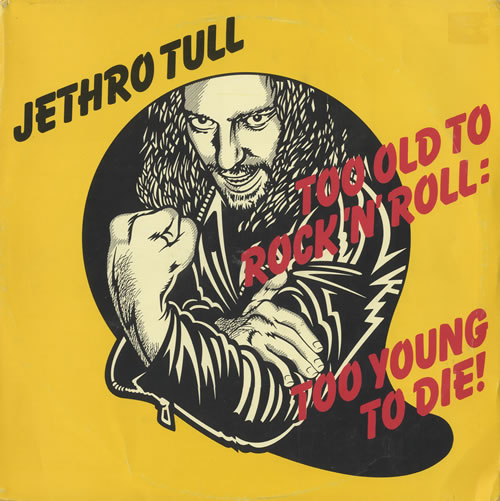Frequently disregarded by their fans as an attempt by bandleader and benign dictator Ian Anderson to simplify the Jethro Tull sound, Too Old to Rock ’n’ Roll: Too Young to Die is in some senses one of their most interesting works. Wedged between the band’s grandiose work of the early 70s, and their late 70s folk-rock trilogy, Too Old to Rock’n’Roll found the band at a crossroads. What was unique was that it was the sound of an established rock band unequivocally pointing out something very obvious – in the music world, fashions change and what may be the next big thing today is tomorrow’s old news. Something was brewing in the mid 70s music scene, and while other established acts were either busy imploding or had their heads in the sand, Tull were one of the few acts to even hint that they knew something was going to make them, and their contemporaries, look very out of date very quickly.
In an effort to streamline the band’s sound, Too Old to Rock ‘n’ Roll: Too Young to Die finds Tull as close to pop-rock as they would ever get, albeit within the familiar format of a concept album. Extended song structures were kept to a minimum, lyrics were totally unambiguous and the concept of the album was spelt out for the hard-of-thinking in comic strip form as part of the artwork. Many hard-line prog fans were aghast at these stylistic changes, but it was still recognisably Tull, albeit a version where Anderson had adopted an unsettlingly geezerish character. This character betrays the origins of Too Old to Rock ‘n’ Roll; Too Young to Die as an intended stage musical, hence Anderson playing a ‘geezer’ throughout the album. A combination of a lack of funding, interest and an innate sense that the whole stage musical idea was a bit naff anyway, ensured that it never saw the light of day, though an ITV special of the band mugging and capering through a mimed version on ITV was broadcast and has been rarely seen since (until perhaps the inevitable 40th anniversary box set of the album, where it will doubtlessly be resurrected on DVD).
To accommodate this (vaguely) more commercial sound, there were various tweaks being made to the Jethro Tull format, as beyond the simplification of the arrangements, Maddy Prior of Steeleye Span and Angela Allen provided female backing vocals. A much more subtle, yet long-lasting tweak was the addition of Allen’s former Carmen bandmate, John Glascock, who had been recruited after Jeffrey Hammond-Hammond hung up his bass to return to painting. Not only was Glascock a more natural sounding bass player than his predecessor, but he was a capable backing vocalist himself, allowing Jethro Tull the luxury of onstage harmonies for the first time in their career. Also fleshing out their role was longtime collaborator David Palmer, who had been an longtime auxiliary member of Tull, providing orchestral arrangements for them since their debut, and stepping forward to guest on saxophone on one of Too Old to Rock ‘n’ Roll’s tracks.
For all of Too Old to Rock ‘n’ Roll’s reputation as a disarmingly straightforward rock album, it’s diversity is actually nicely balanced. “Salamander” is an enjoyable acoustic ditty, while the gentle late-night bar jazz of “From A Dead Beat To An Old Greaser” is home to Dave Palmer’s sax-solo and remains totally unique in the history of the band. When it does rock though, it does it with more obvious choruses and a greater focus on Martin Barre’s guitar riffs. “Quiz Kid” and “Crazed Institution” open the album with a potent double-punch and the standout title track would remain a stalwart of the band’s live set for decades to come. Sadly it does have its lesser moments as well, as both “Taxi Grab” and “Big Dipper” are needlessly clumsy, “Pied Piper”, and “Bad Eyed And Loveless” just doesn’t cut the mustard at all. It’s all worth it at the end though as “The Chequered Flag” is a suitably over-wrought curtain closer which sees Jethro Tull ride off into the distance to face whatever the future may bring (which turned out to be punk).
For all it’s flaws (they didn’t get the album’s mix right until the CD remaster in the early 2003) and its clumsy genesis, Too Old to Rock’n’Roll: Too Young to Die was at least an attempt at something a little different from Anderson and his cohorts, which is more than can be said for the vast majority prog-rock contemporaries at the time. The concept of cyclical fashions and rebirth would become strangely relevant over the following few months, not only for Tull, but for rock music in general. Things were going to change. They had to.














No Comment